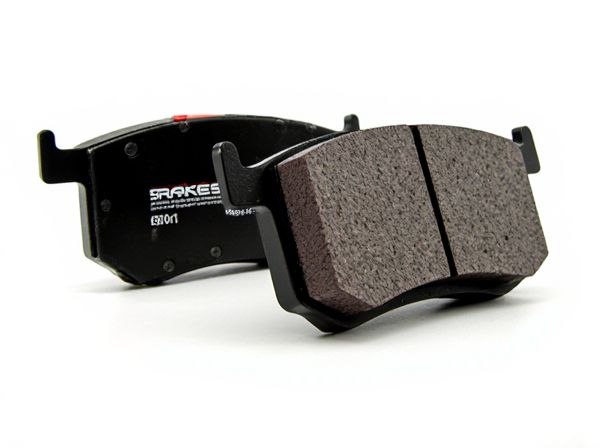
Photo illustration: Race Compound Pads vs Street Compound Pads
Race compound pads offer superior heat resistance and enhanced braking performance, making them ideal for high-speed track conditions where maximum stopping power is crucial. Street compound pads provide balanced durability and quieter operation, designed for everyday driving with smoother brake feel and longer lifespan. Choosing the right pad depends on your driving style, with race compounds suited for aggressive track use and street compounds better for daily commuting.
Table of Comparison
| Feature | Race Compound Pads | Street Compound Pads |
|---|---|---|
| Material Composition | High-friction ceramic or metallic with heat-resistant resins | Organic or semi-metallic materials optimized for durability |
| Performance Temperature Range | 500degF to 1200degF (260degC to 650degC) | 100degF to 600degF (40degC to 315degC) |
| Brake Fade Resistance | Excellent at high temperatures | Moderate; may fade under extreme conditions |
| Pad Life | Short; designed for performance over longevity | Long; optimized for everyday use |
| Noise Level | High; often noisy due to compound hardness | Low; quieter operation preferred for daily driving |
| Dust Production | High; leaves more brake dust | Low to moderate; cleaner wheels |
| Ideal Use | Track racing, competitive driving | City driving, highway cruising |
| Cost | Higher; premium materials and performance focused | Moderate; balanced for cost and reliability |
Introduction to Brake Pad Compounds
Race compound pads deliver superior friction and heat resistance, engineered for high-performance track conditions where intense braking and repeated stops push brake systems to their limits. Street compound pads prioritize a balance between effective stopping power, low noise, and minimal brake dust, designed to perform reliably under everyday driving conditions with a focus on longevity and comfort. Choosing the right brake pad compound depends on the vehicle's usage, with race compounds excelling in track environments and street compounds optimized for daily driving safety and convenience.
What Are Race Compound Pads?
Race compound pads are high-performance brake pads engineered specifically for track and racing conditions, offering exceptional friction and heat resistance. These pads use advanced organic or semi-metallic materials designed to withstand extreme temperatures without fading, providing superior stopping power and consistent pedal feel during aggressive driving. Compared to street compound pads, race compound pads prioritize maximum braking efficiency and durability under intense track demands rather than everyday comfort and low noise.
What Are Street Compound Pads?
Street compound pads are designed for everyday riding, offering a balanced blend of durability, heat resistance, and consistent braking performance suitable for various road conditions. These pads typically feature organic or semi-metallic materials that provide smoother engagement and quieter operation compared to race compounds. Ideal for commuters and casual riders, street compound pads optimize brake control and longevity without sacrificing safety in stop-and-go traffic or variable weather conditions.
Key Performance Differences
Race compound pads deliver superior stopping power and higher heat resistance, making them ideal for track conditions with aggressive braking demands and elevated temperatures. Street compound pads prioritize modulation and low noise, offering consistent performance in a wide temperature range suitable for everyday driving and varied weather conditions. The trade-off involves durability, with race pads wearing faster due to their softer formulations, while street pads maximize lifespan and comfort.
Heat Management and Fade Resistance
Race compound pads feature advanced heat dissipation materials and coatings designed to withstand intense temperatures above 1000degF, ensuring superior fade resistance during aggressive track use. Street compound pads prioritize moderate heat management suitable for typical driving conditions, maintaining consistent friction below 600degF to prevent noise and wear. The enhanced thermal conductivity and higher operating temperature range of race compound pads deliver better performance and durability under extreme braking compared to street compound pads.
Longevity and Wear Comparison
Race compound brake pads typically offer superior stopping power but wear out significantly faster due to their softer materials designed for high heat and performance. Street compound pads prioritize longevity by using harder compounds that endure daily driving conditions with slower wear rates. Comparing longevity, street pads can last several times longer than race compound pads, making them more cost-effective for everyday use despite lower peak performance.
Noise, Dust, and Comfort Considerations
Race compound brake pads generate more noise and dust compared to street compound pads due to their aggressive friction materials designed for maximum performance. Street compound pads prioritize comfort, offering quieter operation and reduced dust buildup to maintain cleaner wheels and a smoother driving experience. Comfort considerations also include better modulation and reduced brake squeal in street pads, making them ideal for everyday use.
Optimal Applications for Each Compound
Race compound pads provide superior braking performance and heat dissipation, making them optimal for track days and racing conditions where high friction and durability under extreme temperatures are essential. Street compound pads offer balanced performance with reduced noise and dust, making them ideal for daily driving, commuting, and casual highway use where comfort and longevity take priority. Selecting the appropriate compound enhances safety and brake system efficiency tailored to specific driving environments.
Safety Implications on Road and Track
Race compound brake pads offer superior stopping power and heat resistance, essential for high-speed track conditions where brake fade can compromise safety. Street compound pads prioritize consistent performance under varied temperatures and everyday driving, enhancing safety with reduced noise, dust, and increased durability. Using race pads on the road can lead to decreased effectiveness at lower temperatures, increasing the risk of unsafe stopping distances during everyday driving conditions.
Choosing the Right Brake Pads for Your Needs
Race compound pads offer superior heat resistance and increased friction for maximum stopping power under high-performance conditions, making them ideal for track racing or aggressive driving. Street compound pads prioritize durability, low noise, and consistent performance in everyday driving situations, providing smooth braking and longer pad life. Selecting the right brake pads depends on your driving style, vehicle usage, and performance requirements to ensure optimal safety and efficiency.
 caratoz.com
caratoz.com